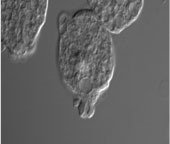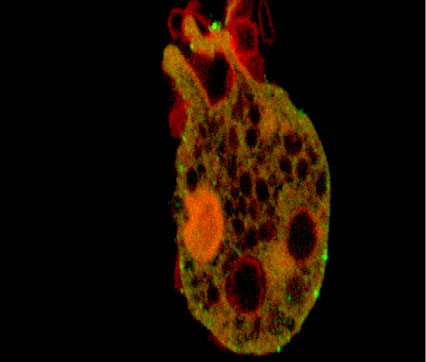Amoebiasis
Enteric protozoa Entamoeba histolytica is a major cause of debilitating diarrhoeal infection worldwide with high morbidity and mortality. Even though the clinical burden of this parasite is very high, this infection is categorized as a neglected disease. Parasite is transmitted through feco-oral route and exhibit two distinct stages namely – trophozoites and cysts. Mechanisms and regulation of virulence and life cycle are not clearly understood. In our lab we are investigating the role of heat shock protein 90 in the regulation of its growth, stage transition and pathogenicity. Cytosolic Hsp90 has been shown to be essential for many infectious pathogens and is considered a potential target for drug development. Using inhibitor 17-AAG, we have shown that Entamoeba depends on Hsp90 for its growth and survival. Hsp90 function in turn is regulated by various co-chaperones. Literature studies suggest an absence of several important co-chaperones of Hsp90 in Entamoeba histolytica. However, in our lab, we have identified a novel homologue of co-chaperone Aha1, EhAha1c which lacks the canonical Aha1 N- terminal domain. Interstingly, this truncated homologue can still bind to Hsp90 and stimulates its ATPase activity (Singh M, et al., J Mol Biol. 2014 Apr 17, 426(8):1786-98). We also for the first time reported that Hsp90 plays a crucial role in life cycle of Entamoeba. Hsp90 is a negative regulator of encystation in Entamoeba. Additionally we have shown that Hsp90 inhibition interferes with the process of phagocytosis in Entamoeba, which is important for its pathogenicity (Singh M, et al., Front. Microbiol. 2015, 6:1125). Overall, we find that Hsp90 plays an important role in growth, virulence and transmission of Entamoeba. In addition to highlighting the potential of Hsp90 inhibitors as drugs against amoebiasis, our studies highlight the importance of Entamoeba histolytica in understanding the evolution of Hsp90 and its co-chaperone repertoire.


